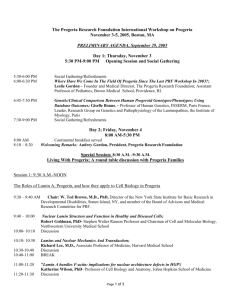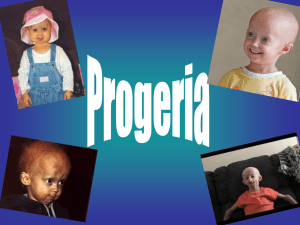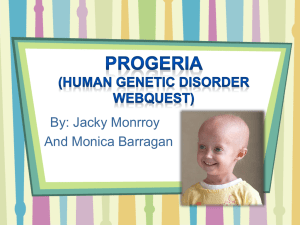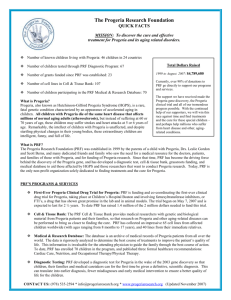racing with sam - Explore Biology
advertisement
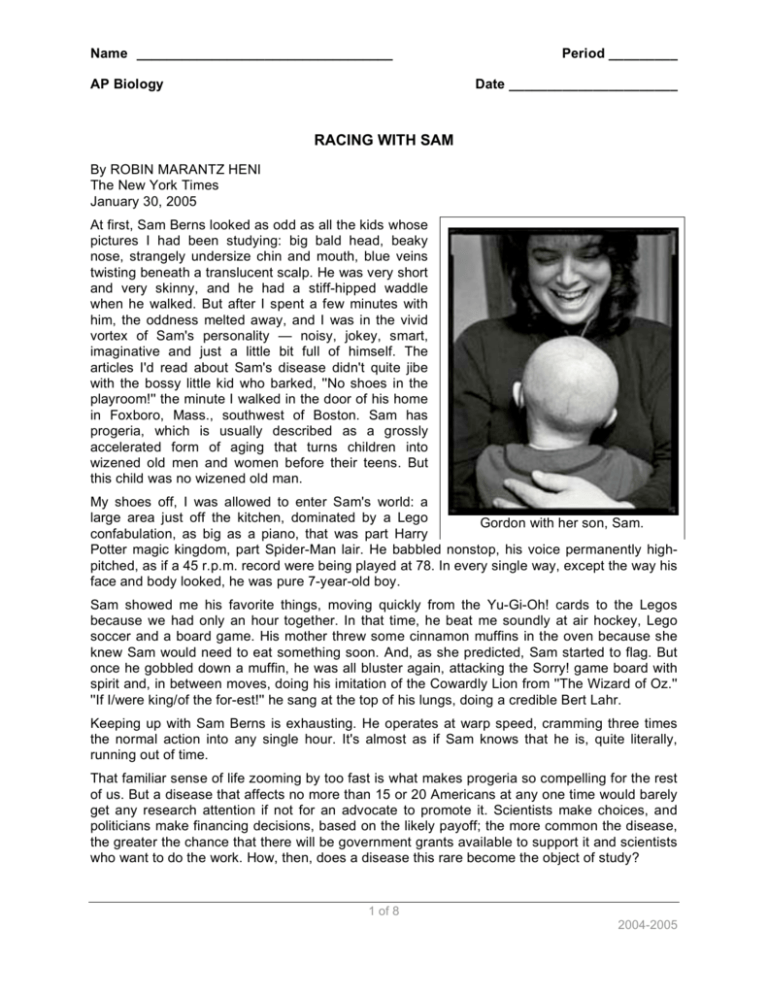
Name __________________________________ AP Biology Period _________ Date ______________________ RACING WITH SAM By ROBIN MARANTZ HENI The New York Times January 30, 2005 At first, Sam Berns looked as odd as all the kids whose pictures I had been studying: big bald head, beaky nose, strangely undersize chin and mouth, blue veins twisting beneath a translucent scalp. He was very short and very skinny, and he had a stiff-hipped waddle when he walked. But after I spent a few minutes with him, the oddness melted away, and I was in the vivid vortex of Sam's personality — noisy, jokey, smart, imaginative and just a little bit full of himself. The articles I'd read about Sam's disease didn't quite jibe with the bossy little kid who barked, ''No shoes in the playroom!'' the minute I walked in the door of his home in Foxboro, Mass., southwest of Boston. Sam has progeria, which is usually described as a grossly accelerated form of aging that turns children into wizened old men and women before their teens. But this child was no wizened old man. My shoes off, I was allowed to enter Sam's world: a large area just off the kitchen, dominated by a Lego Gordon with her son, Sam. confabulation, as big as a piano, that was part Harry Potter magic kingdom, part Spider-Man lair. He babbled nonstop, his voice permanently highpitched, as if a 45 r.p.m. record were being played at 78. In every single way, except the way his face and body looked, he was pure 7-year-old boy. Sam showed me his favorite things, moving quickly from the Yu-Gi-Oh! cards to the Legos because we had only an hour together. In that time, he beat me soundly at air hockey, Lego soccer and a board game. His mother threw some cinnamon muffins in the oven because she knew Sam would need to eat something soon. And, as she predicted, Sam started to flag. But once he gobbled down a muffin, he was all bluster again, attacking the Sorry! game board with spirit and, in between moves, doing his imitation of the Cowardly Lion from ''The Wizard of Oz.'' ''If I/were king/of the for-est!'' he sang at the top of his lungs, doing a credible Bert Lahr. Keeping up with Sam Berns is exhausting. He operates at warp speed, cramming three times the normal action into any single hour. It's almost as if Sam knows that he is, quite literally, running out of time. That familiar sense of life zooming by too fast is what makes progeria so compelling for the rest of us. But a disease that affects no more than 15 or 20 Americans at any one time would barely get any research attention if not for an advocate to promote it. Scientists make choices, and politicians make financing decisions, based on the likely payoff; the more common the disease, the greater the chance that there will be government grants available to support it and scientists who want to do the work. How, then, does a disease this rare become the object of study? 1 of 8 2004-2005 Name __________________________________ Biology That's where Sam Berns's mother comes in. The woman who offered those warm cinnamon muffins for Sam's breakfast is herself a physician-scientist, and she has devoted the last six and a half years of her life to searching for a cure for her son's disease. Since the day in 1998 when Sam's condition was diagnosed, his mother, Dr. Leslie Gordon, has marched to the cruel allegro of her son's illness, which she knew could kill him by the time he reached his teens. She redirected her career, quitting her internship in pediatrics in order to devote herself full time to progeria. She created a nonprofit organization to promote research into the cause and possible treatments and cures. After spending months reading scientific literature, she eventually talked her way into the laboratory of a cell biologist at Tufts University, soon learning enough from him to start her own progeria-research lab. She co-sponsored three major conferences with the help of the National Institutes of Health. She shuttled to Washington to lobby on Capitol Hill, resulting in a legislative coup — specific mention in the Children's Health Act of 2000 — that forced N.I.H. to conduct and support progeria research. And in the spring of 2003, she stood alongside two of the nation's leading geneticists to announce the discovery of the progeria gene. The attention Gordon has generated has been remarkable. From her unique position as both mother and scientist, she has assembled a powerful group of collaborators to push this rare disease to the front of the research agenda. The most zealous among them, of course, is Gordon herself; she has the most to lose. Gordon is motivated by a simple, fierce and ancient passion: the relentless drive of a mother to save her child. The others are motivated by something more complex. On one hand, they're driven by their heads, captivated by the scientific questions they can answer by studying progeria, as well as by the tantalizing possibility that they might learn something about aging itself. On the other hand, they're driven by their hearts in much the same way Gordon is. They want to rescue children who are intelligent, endearing and doomed. You might have heard of progeria. It's known as a disease of accelerated aging, causing children to become withered and wattled and to die of heart attack or stroke at an average age of 13. It first came to general attention in 1981, when the Pulitzer Prize-winning photographer Eddie Adams took a picture of two boys with progeria, Fransie Geringer of South Africa and Mickey Hays of Texas. Craggy-faced and bald under their baseball caps, the boys met in Disneyland, where Fransie was sent by a wish-granting philanthropy called the Sunshine Foundation. The photo was carried on Associated Press wires nationwide and appeared on the front page of the Style section of The Washington Post under the headline ''Growing Up Old.'' The headline, and our conventional understanding of progeria, did not have it exactly right. The children are not quite ''growing up old'' — the disease is not one of being older than their chronological age as much as looking older. But the looks are what resonate. Who among us hasn't felt the strange disconnect between his own internal clock — mine is set permanently at age 19 — and the craggy, lined face that surprises him in the mirror? With progeria, this disconnect is more than just disorienting; it's a death sentence. Children with progeria have wrinkles and age spots, and they're usually bald. They are extremely skinny, and they grow no taller than three or four feet. They never mature sexually, have almost no shoulders and usually have arthritis; their hips tend to lock in a position called a ''horse-riding stance.'' Their faces, disproportionately small for their head size, are odd: beaky noses, prominent eyes, misaligned teeth in shrunken mouths. But internally, what's going on in progeria is not literally aging. Yes, the children die of heart attacks and strokes, which are what kill most elderly people as well. But the underlying cause may be different from the cardiovascular disease of old age. Nor do they get many of the other conditions that plague the elderly, like Alzheimer's disease. 2 of 8 2004-2005 Name __________________________________ Biology Still, despite the imprecision of the analogy, some have found it useful to emphasize this idea of ''growing up old.'' When Gordon created the Progeria Research Foundation in 1999, born at a kitchen table the way so many patient-advocacy groups are, she decided to highlight the possibility that studying progeria might help uncover secrets about normal aging. She has done so cautiously, emphasizing that progeria is one of several ''segmental aging syndromes'' that can offer partial insights into heart disease and how we age. But she has also done so deliberately — because really, what choice did she have? Few scientists can be expected to care about saving a few dozen children, no matter how adorable they are. But everyone is looking for a fountain of youth. Progeria was named by Hastings Gilford, a British surgeon who had a fondness for conditions in which the body's clock and the clock of nature did not quite correspond. In 1897, he published the case studies of four children — two with what he called ''continuous youth'' and two with ''premature old age.'' To the condition of perpetual childhood, in which children failed to grow or to go through puberty, he gave the medical name ''ateliosis,'' Greek for ''not arrived at perfection.'' For asynchrony at the other end of life, he gave the name progeria, from the Greek for ''prematurely old.'' For years, research interest in progeria languished, but a few scientists were intrigued. ''It was fascinating to me that this was a disease that looked so much like aging, yet it affected children,'' said Dr. W. Ted Brown, director of human genetics at the New York State Institute for Basic Research in Developmental Disabilities in Staten Island, who first encountered progeria as a medical student at Harvard in the early 1970's. ''I thought that maybe it could tell us something about the aging process.'' By the late 1990's, Brown was one of the world's leading experts on progeria. Because it affects just one child in every four to eight million births, it's possible for one physician to examine almost everyone who has it in a given generation. Between 1981 and 2001, Brown says, he met ''nearly all'' of the children with progeria in North America, which he estimated at about 60. One of those children was Sam Berns, who was not quite 2 years old when his mother took him to Brown at his laboratory in Staten Island in the summer of 1998. Before she made her way to Ted Brown's office, Leslie Gordon was racing in a very different direction. She had a fresh M.D./Ph.D. joint degree from Brown in her pocket and was on track toward a career in pediatric ophthalmology. She had an accomplished, handsome husband, Dr. Scott Berns, who before their marriage became the youngest board-certified pediatrician in the state of Rhode Island. She had a loving extended family, a beautiful new home and a perfect baby named Sam. When Sam was about 9 months old, his growth curve plummeted, and everything changed. Gordon, now 40, is a petite woman with soft brown hair, soft features and a soft voice. She has the friendly face of the girl next door — but when her baby got sick, she turned into what an admirer once called ''a barracuda.'' She insisted on getting Sam tested for various disorders, but she got no answers for why he was so small, or why his teeth were not coming in. Finally, one dreadful afternoon, a pediatric colleague visiting Hasbro Children's Hospital in Providence took Scott Berns aside. ''I think I've seen this before in textbooks,'' she told him, as gently as she could. ''Have you considered progeria?'' Berns went to the hospital's medical library and found a 1972 paper by Dr. Franklin L. DeBusk, which described four children with progeria and included their photographs. ''And there it was,'' Berns said. ''I looked at those photos, and there was Sam.'' 3 of 8 2004-2005 Name __________________________________ Biology Berns paged Gordon, who had just begun her pediatric internship in the same hospital, and they talked briefly before Gordon had to go back on call. A week later, an X-ray of Sam's collarbone showed that much of the bone had already dissolved — a hallmark of progeria. There was no denying the diagnosis. And Gordon had to hurry back to work; she was on call again. ''It was insane that I had to go back to work that night,'' she told me. ''I felt like I wasn't even a part of my own body. I remember I had a pager on me, so I went out to my car in the parking lot. It was probably 3 or 4 in the morning, and I sat in the car and just started screaming. I was just out of my mind.'' The tragedy of progeria is that it subverts the natural order of things. Parents are supposed to grow old first, while their children blossom and mature in their time. But progeria is a twisted cosmic joke. Gordon and Berns knew that by the time their son was 6, he would in many ways be physiologically older than they. And by the time he was a teenager, he would probably be dead. After two days of full-throttled grieving, Gordon made a conscious decision not to fall apart. She quit her internship and soon started a foundation to catalyze scientific interest in the disease that would kill her son. The clock started ticking. She figured she had, at best, 15 years. In 1999, Gordon became the medical director of the Progeria Research Foundation, which at first was run out of her house in Foxboro. Berns, who also had a master's degree in public health from Harvard, put together the board. Gordon's sister Audrey eventually quit her job as an attorney at a large law firm to work full time as the foundation's executive director. From her scientific training, Gordon knew that the best hope for a cure was in basic research. From his public-health background, Berns knew that the best hope for money to support that research was through Congress, which makes appropriations to N.I.H. and other federal agencies. So the two of them, along with Audrey Gordon, went to Washington and started knocking on doors. In 2000, Berns received a fellowship to learn firsthand how federal policy is made. During his time in Washington, he attended a cocktail party where he met Dr. Francis S. Collins, director of the National Human Genome Research Institute, who was there with his wife. Collins was one of only a handful of scientists who had ever encountered a patient with progeria. More than 20 years earlier, as a postdoctoral researcher at Yale University, he treated a Connecticut woman named Meg Casey. She was the kind of patient a young doctor never forgets. ''Even before I met her, I was warned that I was getting the celebrity,'' Collins recalled. ''Meg was 23 years old at the time, which meant she was way outside the normal boundaries of survival, with the most undaunted, indomitable personality you can imagine — and with a sailor's mouth.'' Meg was only about three feet tall and had the flat-chested body of a child, which, Collins said, was one of the things she fretted about the most. She had difficulty walking because, as he put it, her bones had ''just sort of melted away.'' Through a column she wrote for the local newspaper, she was a community activist, pressing for handicapped access to government buildings in her hometown, Milford, Conn. While at Yale, Collins combed the literature obsessively to find something that would help Meg. ''I was determined that I would somehow figure out something that wasn't done properly for her and save the day,'' he told me. But things didn't turn out that way. Collins left Yale to take a job at the University of Michigan in 1984, and Meg got sicker. She died at age 28. Collins's wife, Diane Baker, who was with him at that cocktail party, had also encountered progeria. In the early 1990's, Baker, then a genetics counselor at the University of Michigan, 4 of 8 2004-2005 Name __________________________________ Biology worked with students who had seen John Tacket of Bay City, Mich., a preschooler with progeria. Just as Meg was an advocate for the disabled, John became an advocate for progeria patients. In his early teens, he appeared on television shows, including ''20/20.'' When he was 13, John was asked what he would tell a child with his abbreviated life expectancy. ''Well,'' he said, ''no one really knows how long they're going to live, so I don't worry about it.'' Meeting Collins and Baker was a lucky break for Scott Berns. What were the odds of encountering a married couple with such stellar credentials who had both been professionally touched by progeria? He told them funny stories about Sam, who was already growing into his gigantic personality. The stories made Collins think of Meg Casey. Collins and Baker invited Berns to bring his family to their house next time they were all together in Washington. That happened in the early spring of 2001. After lunch, the adults and Sam, then 4 1/2, played Frisbee in the backyard. Collins signed on to the family's venture, thereby helping Gordon lasso other prominent scientists for her conferences. And he pasted a school photo of Sam, looking snazzy in a vest and tie, right next to his home computer. The race to find the progeria gene gained focus at the closing session of a two-day conference sponsored by the Progeria Research Foundation and the National Institute on Aging, a branch of N.I.H. It was the week after Thanksgiving in 2001. Brown was there, as were Collins and his new postdoctoral researcher, Maria Eriksson. There were few clues about where even to begin the gene hunt, but one clue pointed to Chromosome 1. Brown was already looking there, ever since he treated a pair of identical twin boys with progeria, who died in 1991, within one month of each other, at the age of 8. A biopsy from one twin's skin cells showed that on Chromosome 1 he had a genetic flaw called an inverted insertion, in which a small piece of the chromosome splits off, flips over and slips back in. By the time the progeria gene consortium was organized in early 2002, scientists at the University of Michigan were trying to sequence the genes on either side of the inverted insertion, to see what damage might have been done to nearby genes. A short time later Eriksson, at Collins's lab, found a different defect in skin cells from two other progeria patients. This defect, called an isodisomy, was also on Chromosome 1. It indicated that the skin cells carried two identical copies of a chromosome segment from one parent, and nothing from the other parent. It hardly ever happens — and yet Eriksson found it in not one progeria patient, but two. ''So here we had this rare disease, progeria, and this really rare finding, isodisomy,'' Collins said. ''Rare-squared isn't supposed to happen.'' On a hunch, Eriksson went back to look again at the skin cells of Brown's patient, the identical twin. There she found a second genetic flaw in the same region of Chromosome 1: a microdeletion, about the size of six million nucleotides. Eriksson reasoned that the gene must exist somewhere within those six million nucleotides. Six million sounds like a lot, but in the context of the three billion nucleotides in the whole human genome, it's only a speck. It allowed Eriksson to zero in on a single region: a very specific 0.2 percent of the genome, somewhere on the long arm of Chromosome 1. The next step was to go online. Eriksson browsed the Web site of the Human Genome Project to see what genes existed in the target region. One in particular caught her eye: the gene that produces the protein lamin A. Scientists already knew that lamin A helps maintain the structural integrity of the cell, especially the scaffold supporting the membrane around the nucleus. LaminA disorders lead to a wide range of rare diseases, among them a form of heart enlargement, a 5 of 8 2004-2005 Name __________________________________ Biology form of muscular dystrophy and mandibuloacral dysplasia (MAD). Interestingly, MAD is sometimes mistaken for progeria. Could that be significant? By looking at samples from 20 progeria patients, Eriksson found that the lamin-A gene in almost all of them was abnormal in one consistent way. Instead of a C nucleotide in one spot of Chromosome 1, progeria patients had a T. Eriksson worked closely with Collins to try to make sense of her findings, and they were in regular contact with Gordon and the others in the 20-member gene consortium. At first it looked as if that single-letter typo, one mistake out of three-billion-plus letters, should have been meaningless, since it didn't seem to change anything about the way the cell went about performing its main task, producing proteins. But, as the other scientists continued to study the mutation, and as Gordon kept providing fresh batches of cells from her foundation's tissue repository, the truth gradually emerged. The C-to-T error was enough to lead the cell to manufacture a stunted form of the lamin-A protein. Gordon named the defective protein progerin. ''When we first found the gene, a little bit of me panicked,'' Gordon said. ''My first thoughts were, I don't know how to fix this.'' For most geneticists, finding a disease gene is cause for celebration, a way to gain new insight into how a disease works and, often, how other parts of the body work as well. But Gordon is a mother first and a geneticist second, and what she wanted out of that gene discovery was simple, and all but impossible: a crystal-ball insight into how to save Sam. Eriksson sequenced the DNA from more skin samples to confirm her finding. Some of them were provided by Gordon, and others had been stored at the Coriell Cell repository in Camden, N.J. Out of the first 20 she looked at, she found two samples with slight variations from the common progeria mutation: instead of a C-to-T typo, it was something else. In fact, it was similar to a mutation that had previously been associated with MAD. Eriksson leafed through the clinical descriptions of the two patients whose samples she was looking at, hoping for more information. Collins, trying to help solve the puzzle, asked Eriksson if he could see the clinical descriptions, too. Suddenly, he got woozy. ''I began reading the description of a 24-year-old female patient, and the more I read the more I thought, This looks familiar,'' he recalled. So he looked at the bottom of the report for the physician's name — and there was his own signature. ''It was so strange, so incredibly otherworldly,'' he said. ''I'd almost forgotten I'd submitted the sample to Coriell.'' But it was indeed the sample of Meg Casey, Collins's first progeria patient. Collins had taken a blood sample and sent it in to be stored — way back in the early 1980's. Now, more than 20 years later, he at last had a genetic explanation for why she lived to twice the average life span of progeria patients. Meg had not had progeria at all; she had had MAD. By this time, Meg's accurate diagnosis was almost beside the point. Collins might have originally been fired up about studying progeria because of her, but by now he had other reasons. There were intellectual reasons: the single nucleotide change told a remarkable story about how DNA works; the progeria protein offered insights into how cells retain their structural integrity and why it matters; and the genetic information could suggest treatment strategies for other lamin-A disorders. And there were emotional reasons, too, personified by Sam Berns. For all the valid reasons to study progeria, however, the real payoff would be if doing so could reveal something about the fate awaiting all of us: relentless, sorrowful, garden-variety aging. The question of whether progeria is just normal aging at a faster pace, or a specific disease that bears little resemblance to true aging, remains unsettled. Collins said he believed there might 6 of 8 2004-2005 Name __________________________________ Biology yet turn out to be a connection. At the April 2003 press conference in Washington announcing the gene discovery, he emphasized that knowing the gene ''not only gives hope to children and families affected by progeria, but also may shed light on the phenomenon of aging.'' Following up on this possibility, Collins tried an experiment in which he compared people with progeria — who could be thought of as having the worst possible aging genome — with people who live to be 100, who could be thought of as having the best. In collaboration with Elixir Pharmaceuticals, a company in Cambridge, Mass., that had a large genetic database of centenarians, Collins compared the centenarian sample with a group of control subjects to see whether the lamin-A gene was different in centenarians than in the population at large. The first time the scientists did the analysis, in mid-2003, they detected a particular version of the lamin-A gene that was somewhat more common in the centenarians. This could indicate that lamin A was somehow a pacemaker for aging: one variant prolonging life, the other cutting it short. Excited, Collins tried to replicate his findings. But he couldn't. At Elixir, investigators decided not to explore the possible connection between lamin A and aging any further. But Collins continues to hold out hope, and plans to reanalyze the genomic data on the centenarians one more time. ''I'm not willing to say it's over,'' he said recently. Other scientists have also been swept up by Gordon's passion. Among them is Dr. Elizabeth Nabel, scientific director of clinical research of the National Heart, Lung and Blood Institute at N.I.H. Nabel's main research interest is cardiovascular biology and medicine, but she was turned on to progeria after attending one of Gordon's workshops in the summer of 2003. Nabel made no assumption that studying progeria would explain cardiovascular disease in the rest of us. But she didn't think it needed to; she told me that N.I.H. scientists have ''an obligation as public servants,'' without any additional justification, to investigate diseases that drug companies have no interest in. ''These kids don't develop atherosclerosis the way adults do,'' she said. Gordon has found that their levels of cholesterol and triglycerides, which are elevated in adults with heart disease, were usually normal. This led Nabel to hypothesize that something other than fatty deposits might be clogging their blood vessels. Nabel's theory is that excessive cell death in the vessel walls is responsible for the clogging. ''I think it's going to turn out to be an interesting story scientifically,'' she said. ''By studying progeria, we will learn quite a bit about fundamental mechanisms of cell growth and cell death.'' An added benefit — indeed, in many ways, the primary benefit to a scientist like Nabel, who also happens to be a mother — would be finding a cure for progeria. ''At the meetings I've gone to, Leslie has shown enough video clips of these kids,'' she said. ''And it just captures your heart.'' Now that his mother has catapulted the research to the discovery of his disease gene, is Sam Berns, who turned 8 on Oct. 23 and is thriving in second grade, on the brink of being cured? Unfortunately, no. Gene discoveries rarely morph into instantaneous cures: the gene for cystic fibrosis, for instance, was discovered in 1989, but in the 16 years since then no magic cystic fibrosis bullet has been found. Finding the progeria gene might have given an emotional boost to the research effort, and has allowed scientists to zero in on better theories about its cause. But a cure is still years away. More with a mother's passion than with a scientist's detachment, Gordon is trying now to direct research interest toward experimental treatments: bone-marrow transplantation, stem-cell therapy and use of an emerging technology known as RNA interference, which was only recently approved for human testing. These are risky, experimental procedures that could lead to real hazards if they fail. 7 of 8 2004-2005 Name __________________________________ Biology Gordon is one of the associate investigators, along with Nabel, of a major longitudinal study of progeria. In groups of two or three, children with progeria will come to the N.I.H. Clinical Center in Bethesda, Md., for five days of laboratory tests to see how various organ systems are affected. The plan is for the children to return for follow-up two years later to chart progeria's natural course. Although Gordon would ordinarily be one of the people asking for informed consent from the study subjects and their parents, the ethics board overseeing the longitudinal study specifically prohibited Gordon from taking on that role. Anyone who spends any time with Gordon can see that she cannot be dispassionate about this topic and might, inadvertently, pressure the parents to participate. Sam's disease has set her own internal metronome at a faster tempo and, like her son, she is desperately racing against time. A cure is already too late for John Tacket, the boy whom Diane Baker first heard about in Michigan more than a decade ago. John appeared at the press conference in Washington announcing the gene finding in April 2003, a dashing kerchief tied around his bald head. Ten months later, he died, at 16, of cardiac arrest at his home in Michigan. As for Sam, who thought of John as a cool older friend, not much can be done to stave off his decline. He has physical therapy three times a week to keep his joints supple. And his parents give him growth-hormone shots, which they say they think is helping, as well as the low-dose aspirin recommended for older people at risk for heart attacks. Gordon speaks in practiced paragraphs about the science of progeria, but talking about Sam's prospects makes her stumble. When I asked a question about how she'll feel when Sam dies, she changed the vocabulary to something she could tolerate. She talked about how she'll feel ''if Sam passes away'' — not ''dies,'' but ''passes away''; not ''when,'' but ''if.'' She has, in emotional terms, set herself an impossible task. Already she is devastated by the death of every child with progeria. ''I know objectively that it's not my fault,'' she said. ''But still that's how I feel, like I should have gone faster. I ask myself: Should we have done more? Should we have done it better?'' It makes her furious and sad, she said, to know that since her research foundation has been around, several children with progeria have died anyway. ''Everybody talks about how fast we're going,'' Gordon said, taking a phone interview while waiting to pick up Sam from his drum lessons. ''But the truth is, we're not going fast enough.'' Robin Marantz Henig is the author of ''Pandora's Baby: How the First Test Tube Babies Sparked the Reproductive Revolution.'' Her last article for the magazine was about the genetics of race. Copyright 2005 The New York Times Company 8 of 8 2004-2005 Name __________________________________ AP Biology Period _________ Date ______________________ QUESTIONS: RACING WITH SAM NY Times, January 30, 2005 1. What is progeria? __________________________________________________________________________ __________________________________________________________________________ __________________________________________________________________________ __________________________________________________________________________ __________________________________________________________________________ 2. Is it accurate to describe progeria as accelerated aging? Explain. __________________________________________________________________________ __________________________________________________________________________ __________________________________________________________________________ __________________________________________________________________________ __________________________________________________________________________ __________________________________________________________________________ 3. How can a single base change in a single gene cause so many effects in an organism? __________________________________________________________________________ __________________________________________________________________________ __________________________________________________________________________ __________________________________________________________________________ __________________________________________________________________________ 1 of 2 2004-2005 Name __________________________________ Biology 4. Can one dedicated individual really make a difference in the speed of scientific discovery? __________________________________________________________________________ __________________________________________________________________________ __________________________________________________________________________ __________________________________________________________________________ __________________________________________________________________________ 5. How could a child with progeria be cured? __________________________________________________________________________ __________________________________________________________________________ __________________________________________________________________________ __________________________________________________________________________ __________________________________________________________________________ 2 of 2 2004-2005
